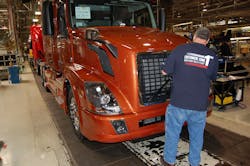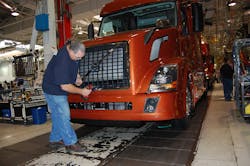Class 8 orders in October exceeded analyst expectations by a wide margin and indicates that, as long as freight volume and the broader U.S. economy hold up, conditions are setting up for strong heavy-duty truck production volumes through the end of the decade.
According to data track by consulting firm ACT Research, North American Class 8 net orders “significantly surpassed expectations,” reaching 36,200 units, which is 60% higher compared to September and 160% higher compared to October of 2016.
Research firm FTR Transportation Intelligence reported similar numbers, with its data indicating preliminary North American Class 8 net orders hit the 35,700 unit mark, which is a month-over-month increase of 62% versus September and a year-over-year increase of 167% compared to October of last year.
While growth in orders “was not uniform” across all the major truck OEMs, Jonathan Starks, FTR’s COO, said that nearly every manufacturer witnessed a month-over-month increase. According to his firm’s data, North American Class 8 orders for the past twelve months now total 261,500 units, with the market seemingly “well situated” for a strong production environment to persist into 2018.
“October’s preliminary orders clearly put upward pressure on our expectations for Class 8 demand next year,” added Kenny Vieth, ACT’s president and senior analyst. “At the same time, we recognize the potential that this year’s NACV [North American Commercial Vehicle] show in September may have pulled-forward the timing of orders that would normally have been placed through the fourth quarter.”
Michael Baudendistel, vice president of the transportation & logistics research group at Stifel Capital Markets, added in a research brief that “there has been plenty of optimism heading into order season,” with fleets “increasingly upbeat” given ongoing improvements in freight volumes and a “surging spot market,” though spot rates have softened slightly over the last three weeks, according to DAT Solutions.
Baudendistel also noted that following two years of reduced spending by many large fleets, some were overdue for a refresh on some of their older trucks and are now placing orders to do so.
As a result, Stifel’s Class 8 production forecast for 2018 is being pegged at 280,000 units, up 12% compared to 2017.
Baudendistel also believes the 36,000-plus Class 8 orders in October “were stronger than most expected” and sends a “good signal” that the outlook for 2018 and beyond “have not been too optimistic.”
While 2018 looks good, “we believe the 2019-2020 outlook is even better,” he added.
“While we are still many months away from having more clarity on what production will look like in 2019 and 2020, we believe conditions are setting up for a strong end to the decade—as long as freight volume and the broader economy hold up,” Baudendistel said.
From Stifel’s point of view, three main factors support that bullish outlook for strong heavy-duty truck production volumes:
- Replacement demand should increase significantly in 2019-2020 as trucks purchased in 2014 and 2015 will be hitting the end of the typical four- to five-year holding period for new truck buyers.
- Improved motor carrier profitability as the “real benefit” of contract freight rate increases will be felt by fleets later in 2018; as that improved cash flow hits the bottom line – assuming fleets do not have to give back too much in the way of driver pay increases – some motor carriers may be more inclined to increase spending on new trucks, Baudendistel noted.
- New regulations, the most significant being the ELD mandate that goes into effect on December 18, will result in “a reduction in effective capacity” could disproportionately benefit large motor carriers and drive demand for more trucks, as big fleets are typically the buyers of new trucks.
In terms of the medium-duty truck segment, Baudendistel said Class 5-7 orders in October totaled 19,500 units, down 2% year-over-year.
However, he said Stifel “continues to believe medium duty production will be up modestly next year” with the firm’s current Class 5-7 forecast pegging total North American medium-duty production at 257,000 units for 2018, which is 4% higher than expected 2017 volumes.
About the Author
Sean Kilcarr
Editor in Chief
Sean Kilcarr is a former longtime FleetOwner senior editor who wrote for the publication from 2000 to 2018. He served as editor-in-chief from 2017 to 2018.

